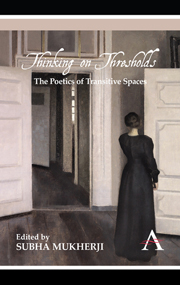Book contents
- Frontmatter
- ACKNOWLEDGEMENTS
- Contents
- List of Illustrations
- Notes on Contributors
- Introduction
- Part One Doors, Windows, Entries
- Part Two Lives and Narratives, Territories and Worlds
- Part Three Matter, Mind, Psyche
- Part Four Reading, Writing, Playing, Listening
- 11 Reading on the Threshold
- 12 When I Begin I have Already Begun
- 13 Thresholds in Improvisation: Freedom, the Eternal Present, and the Death of Jazz
- 14 Thresholds of Attention: On Listening in Literature
- Select Bibliography (including Discography)
14 - Thresholds of Attention: On Listening in Literature
from Part Four - Reading, Writing, Playing, Listening
Published online by Cambridge University Press: 05 March 2012
- Frontmatter
- ACKNOWLEDGEMENTS
- Contents
- List of Illustrations
- Notes on Contributors
- Introduction
- Part One Doors, Windows, Entries
- Part Two Lives and Narratives, Territories and Worlds
- Part Three Matter, Mind, Psyche
- Part Four Reading, Writing, Playing, Listening
- 11 Reading on the Threshold
- 12 When I Begin I have Already Begun
- 13 Thresholds in Improvisation: Freedom, the Eternal Present, and the Death of Jazz
- 14 Thresholds of Attention: On Listening in Literature
- Select Bibliography (including Discography)
Summary
And what do I point to by the inner activity of listening? To the sound that comes to my ears, and to the silence when I hear nothing?
WittgensteinI am sitting on a terrace in Sicily, listening to the sound of the sea breaking on the rocks below.
That statement, in the present, is not quite true of course, at least no longer quite true, because the time of sitting, and even the time of writing that ‘I am sitting’, have already slipped into some future, anytime, anywhere, of the reader who reads it, and who, in a kind of reverse action, then understands that ‘I am sitting’, but also, with luck, imagines that he or she might also be sitting, ‘listening to the sound of the sea’. Writing plays lovely tricks on our willing ears. But it reminds us, too, that in order to read with attention we must cross all sorts of time-barriers and place-barriers, journeying across varieties of half-truths, like ‘I am sitting’, which we have mostly learned to cross by convention, but which the literary text asks us to cross again in imagination.
And much of this activity happens in the ear, that subtle, often underrated organ, which is itself composed of a series of halls and obstacles which transmit sound waves to the brain. First of all, there is not one ear, but three: in medical terminology, the outer, the middle, and the inner ear.
- Type
- Chapter
- Information
- Thinking on ThresholdsThe Poetics of Transitive Spaces, pp. 199 - 212Publisher: Anthem PressPrint publication year: 2011



